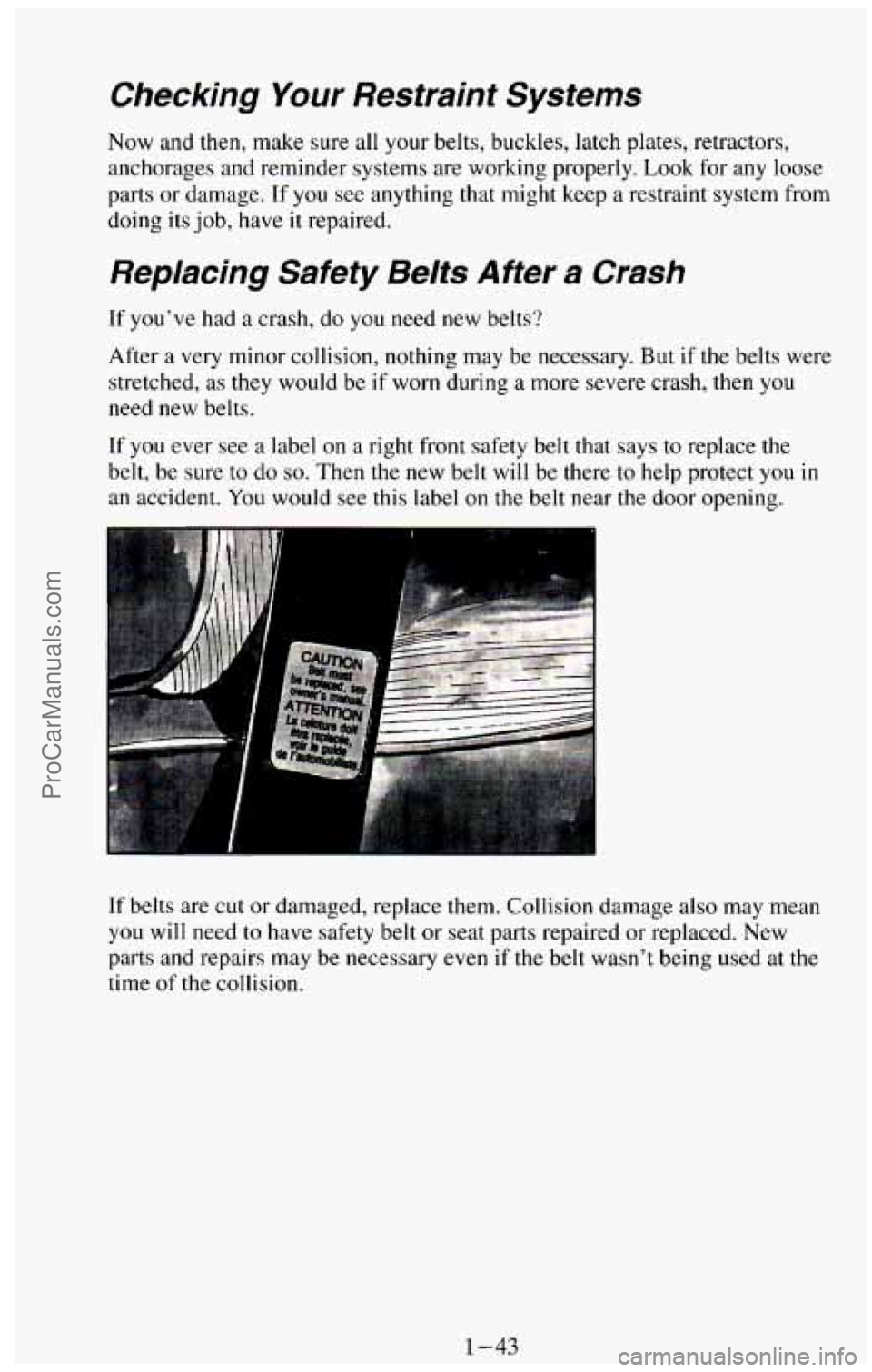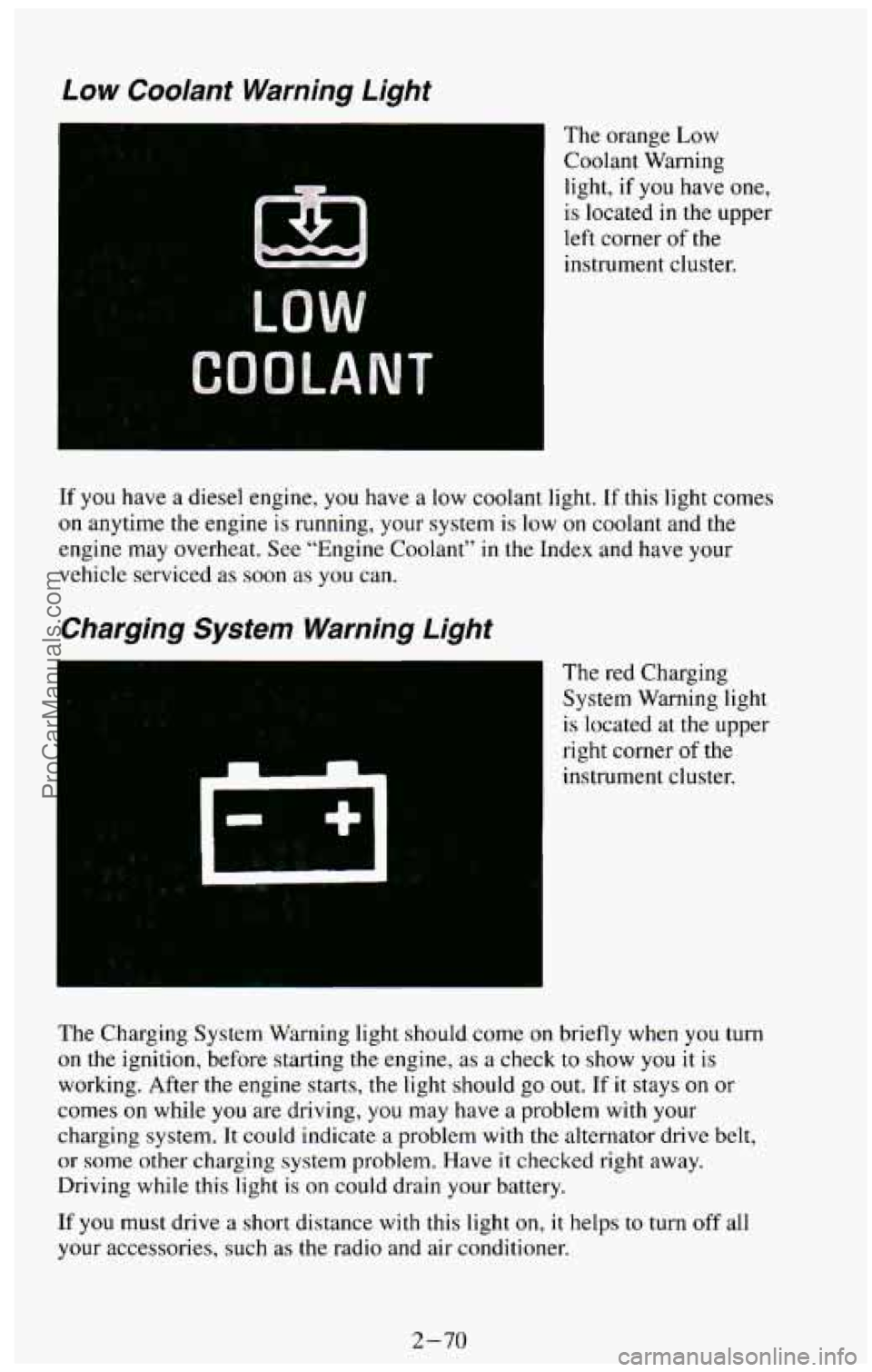Page 53 of 385
Wherever the child sits, the lap portion of the belt should be worn low and
snug
on the hips, just touching the child’s thighs. This applies belt force to
the child’s pelvic bones in
a crash.
Safety Belt Extender
If the vehicle’s safety belt will fasten around you, you should use\
it.
But if a safety belt isn’t long enough to fasten, your dealer will order you an
extender. It’s free. When
you go in to order it, take the heaviest coat you
will wear,
so the extender will be long enough for you. The extender will be
just for you, and just for the seat
in your vehicle that you choose. Don’t let
someone else use it, and use it only for the seat it is made to fit. To wear it,
just attach it to the regular safety belt.
ProCarManuals.com
Page 54 of 385

Checking Your Restraint Systems
Now and then, make sure all your belts, buckles, latch plates, retractors,
anchorages and reminder systems are working properly. Look
for any loose
parts
or damage. If you see anything that might keep a restraint system from
doing its job, have it repaired.
Replacing Safety Belts After a Crash
If you’ve had a crash, do you need new belts?
After
a very minor collision, nothing may be necessary. But if the belts were
stretched,
as they would be if worn during a more severe crash, then you
need new belts.
If you ever see a label on a right front safety belt that says to replace the
belt, be sure to do
so. Then the new belt will be there to help protect you in
an accident. You would see this label on the belt near the door opening.
I
If belts are cut or damaged, replace them. Collision damage also may mean
you will need to have safety belt or seat parts repaired or replaced. New
parts and repairs may be necessary even
if the belt wasn’t being used at the
time
of the collision.
1-43
ProCarManuals.com
Page 55 of 385
Q: What’s wrong with this?
A: The belt is torn.
Torn or frayed belts may not protect you in a crash. They can rip apart under
impact forces.
If a belt is torn or frayed, get a new one right away.
Before replacing any safety belt, see your dealer for the correct part number.
You’ll need the model year and model number for your vehicle. The model
year is on your title and registration. And you can find the model number on
the Certificatioflire label of your vehicle. See “Certificatioflire Label” in
the Index.
I
The model number on
the replacement belt
must be listed on the
safety belt you want to
replace. Pull the
shoulder belt all the
way out to see this
label.
ProCarManuals.com
Page 125 of 385

Low Coolant Warning Light
The orange Low
Coolant Warning
light, if
you have one,
is located in the upper
left corner of the
instrument cluster.
If
you have a diesel engine, you have a low coolant light. If this light comes
on anytime the engine is running, your system is low on coolant and the
engine may overheat. See “Engine Coolant”
in the Index and have your
vehicle serviced
as soon as you can.
Charging System Warning Light
The red Charging
System Warning light
is located at the upper
right corner of the
instrument cluster.
The Charging System Warning light should come on briefly when you turn
on the ignition, before starting the engine, as a check to show you it is
working. After the engine starts, the light should go out. If it stays on or
comes
on while you are driving, you may have a problem with your
charging system. It could indicate a problem with the alternator drive belt,
or
some other charging system problem. Have it checked right away.
Driving while this light is on could drain your battery.
If
you must drive a short distance with this light on, it helps to turn off all
your accessories, such
as the radio and air conditioner.
2-70
ProCarManuals.com
Page 161 of 385

Defensive Driving
The best advice anyone can give about driving is: Drive defensively.
Please start with a very important safety device
in your vehicle: Buckle up.
(See “Safety Belts”
in the Index.)
Defensive driving really means “be ready for anything.” On city streets,
rural roads, or freeways, it means “always expect the unexpected.”
Assume that pedestrians or other drivers are going to be careless and make
mistakes. Anticipate what
they might do. Be ready for their mistakes.
Rear-end collisions are about the most preventable
of accidents. Yet they
are common. Allow enough following distance. It’s the best defensive
driving maneuver, in both city and rural driving. You never know when the
vehicle in front of you is going to brake or turn suddenly.
Drunken Driving
Death and injury associated with drinking and driving is a national tragedy.
It’s the number
one contributor to the highway death toll, claiming
thousands
of victims every year. Alcohol takes away three things that
anyone needs to drive a vehicle:
Judgment
Muscular Coordination
Vision
Police records show that almost half
of all motor vehicle-related deaths
involve alcohol
- a driver, a passenger or someone else, such as a
pedestrian, had been drinking. In most cases, these deaths are the result of
someone who was drinking and driving. About
20,000 motor
vehicle-related deaths occur
each year because of alcohol, and thousands of
people are injured.
Just how much alcohol is too much if a person plans to drive? Ideally, no
one should drink alcohol and then drive. But if one does, then what’s “too
much”? It can be a
lot less than many might think. Although it depends on
each person and situation, here is some general information on the problem.
The Blood Alcohol Content (BAC) of someone who
is drinking depends
upon four things:
0 How much alcohol is in the drink.
0 The drinker’s body weight.
The amount of food that is consumed before and during drinking.
The length of time it has taken the drinker to consume the alcohol.
4-2
ProCarManuals.com
Page 167 of 385

What should you do if this ever happens? Ease up on the accelerator pedal,
steer the vehicle the way
you want it to go, and slow down.
Speed limit signs near curves warn that
you should adjust your speed. Of
course, the posted speeds are based on good weather and road conditions.
Under less favorable conditions you’ll want
to go slower.
If you need to reduce your speed as you approach a curve, do it before you
enter the curve, while your front wheels are straight ahead.
Try
to adjust your speed so you can “drive” through the curve. Maintain a
reasonable, steady speed. Wait
to accelerate until you are out of the curve,
and then accelerate gently
into the straightaway.
Steering in Emergencies
There are times when steering can be more effective than braking. For
example,
you come over a hill and find a truck stopped in your lane, or a car
suddenly pulls out from nowhere, or a child darts out from between parked
cars and stops right
in front of you. You can avoid these problems by
braking
- if you can stop in time. But sometimes you can’t; there isn’t
room. That’s the time for evasive action
- steering around the problem.
Your vehicle can perform very well
in emergencies like these. First apply
your brakes. It is better to remove as much speed as you can from a possible
collision. Then steer around the problem, to the left or right depending on
the space available.
An emergency like this requires close attention and a quick decision. If
you
are holding the steering wheel at the recommended 9 and 3 o’clock
positions, you can turn it a full
180 degrees very quickly without removing
either hand. But you have
to act fast, steer quickly, and just as quickly
straighten the wheel once you have avoided the object.
The fact that such emergency situations
are always possible is ii good reason
to practice defensive driving at all times and wear safety belts properly.
4-8
ProCarManuals.com
Page 203 of 385
Maintenance When Trailer Towing
Your vehicle will need service more often when you’re pulling a trailer. See
the Maintenance Schedule for more on this. Things that are especially
important in trailer operation are automatic transmission fluid (don’t
overfill), engine oil, axle lubricant, belt, cooling system, and brake
adjustment. Each
of these is covered in this manual, and the Index will help
you find them quickly. If you’re trailering, it’s a good idea to review these
sections before you start your trip.
Check periodically to see
that all hitch nuts and bolts are tight.
Trailer Light Wiring
See “Trailer Wiring Harness” in the Index.
4-44
ProCarManuals.com
Page 259 of 385
Checking Things Under the Hood
Hood Release
To open the hood, first
pull the handle inside
the vehicle.
Then go to the front of
the vehicle and pull up
on the secondary hood
release, located just to
the passenger side
of
the center of the grill.
Lift the hood.
Your vehicle,
if it has
air conditioning, may
have a auxiliary
engine fan in addition
to the belt driven fan.
6-14
ProCarManuals.com